Star Anise is our Spice Choice for June!
In my volunteer job I have cataloged the plants of a very large property in the Victoria area. This entails comparing the on hand information with what I know and can find out from various reputable sources that are available to me. The plant collection was mostly planted nearly 100 years ago and this has lead me to become interested in other similar collections of the same age in the area. One such collection is very close to where I live and i was lucky to meet a lady who had done exactly the same job there. She briefly told me about the collection and then showed me a plant which does not grow anywhere else that she or I knew of. It was the Star Anise(Illicium vernum) the wonderful sweet licorice-like spice plant.
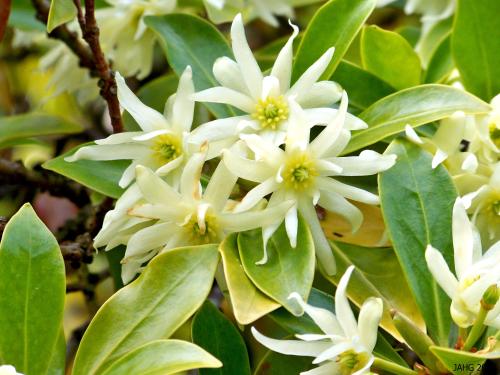
The interesting Illicuim vernum flowers which are related to Magnolias.
Here in the Victoria area Star Anise are absolutely at the coldest limits of where it can survive. Normally these plants grow into trees up to 5m (18ft) tall, yet here and in the in warmer areas of Great Britain it can only muster up a lumpy 3m (9-10ft) shrub form. This shrub is a common site in many areas of Asia including Vietnam north through China and Korea. It was imported into Japan by Buddhists and is often found growing beside temples and in grave sites. It is now grown in southeastern U.S.A. as a spice crop.
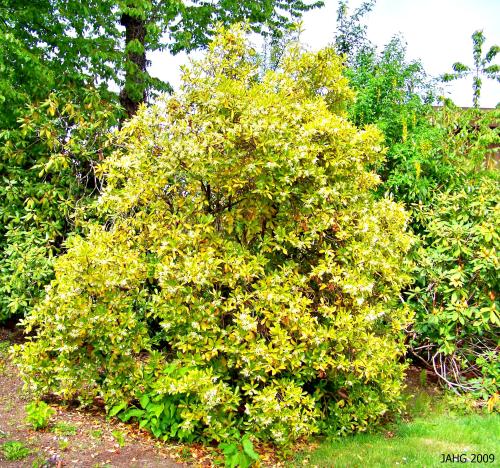
Illicium vernum Also Known as Star Anise or Aniseed.
Medicinally Star Anise has many useful properties. It has commonly been used as a carminative(reducing flatulence and other internal gases) , stimulant and as a stomachic which strengthens and tones the stomach. It is useful in promoting digestion and appetite which is not surprising as that is what the other ‘Anise’(Pimpinella anisum) is used for. It has also been used for colic in babies and a treatment for rheumatism. With it’s wonderful and strong flavor, it is often added to medicines to make them more palatable. Homeopaths make a weak infusion or prescribe a stronger tincture which is diluted in a liquid. This will be made using the crushed seeds. the bark is pounded and used to make fragrant insense.
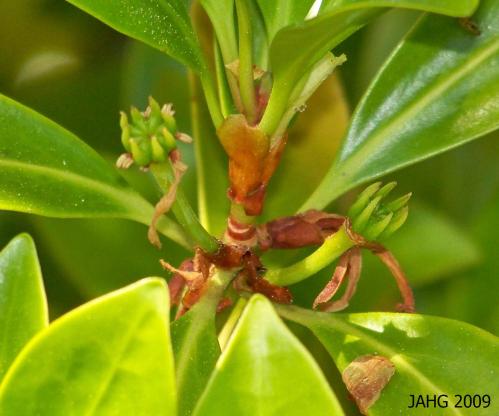
Star Anise Seeds are starting to develope from a recent bloom.
To grow one of these interesting plants you will need to live in a warm climate to produce the best specimen. Zone 8 or above is a must to produce one a healthy Illicium vernum. It likes light sandy to medium loamy soil which is well drained. It grows best in a shaded position which is protected from cold winds to protect it’s glossy dark green evergreen leaves. As a shrub it has many uses such as in a shrub boarder or as a screen or fragrant hedge. it also works well as background shrub which can be used in a shady area.
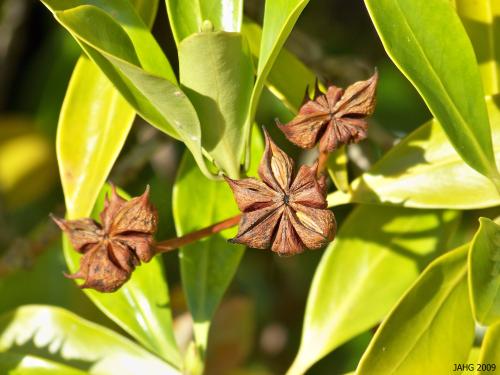
Star Anise with it's star-like seed capsules.
The Latin name of ‘Star Anise‘ is Illicuim (meaning allurement) vernum (which refers to spring). As you can see the fruit capsules are formed into a star-like structure which is where the plant gets it’s name. There are even better examples that the above picture, maybe the cold effects the fruit structure.
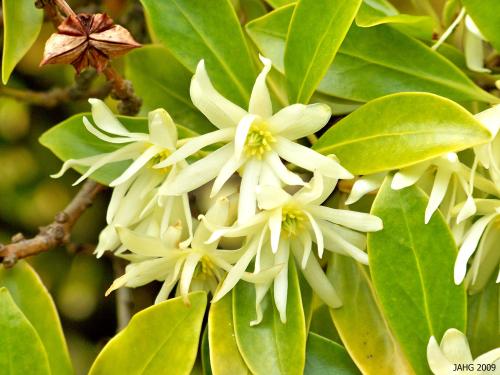
The flowers of Illicium vernum are very primitive.
To find out more about Star Anise:
The Wiki page is interesting: http://en.wikipedia.org/wiki/Star_anise
The best place to learn about any spice: http://www.uni-graz.at/~katzer/engl/Illi_ver.html
Until next month….
From Kim: Star Anise – June’s Herb of Choice!
 |
| Star anise flower – www.botany.hawaii.edu © Gerald Carr |
Five spice powder is often added to a batter made from egg white and cornstarch, which is used to coat meats and vegetables to keep them moisty and succulent during deep-frying. Meat is also frequently coated with a mixture of corn starch and five spice powder and deep-fried. Lastly, it is often contained in marinades for meat to be stir-fried. Since the mixture is very aromatic, it should be used with care. The subtle aroma of five spice powder is particularly effective in steamed foods. Steamed pork belly can indeed be a delicacy, even if it is, of course, never low in fat. For this recipe, the so-called five-flower cut is used that consists of three fatty and two lean layers. The meat is marinated in soy sauce and garlic, coated by a mixture of five-spice powder and ground, toasted rice and steamed until very tender (wu hua rou [五花肉]). This pork dish is very mild, but highly aromatic and pleasing. For more examples of star anise in Chinese cookery, see orange about the Sichuan-style beef stew au larm and cassia about master sauce. Outside China, star anise is less valued. In the North of Vietnam, it is popular for beef soups (see Vietnamese cinnamon). Star anise is also used in Thailand: In the North, it is often employed in long-simmered stews; elsewhere, especially in the tropical South, it is a common flavourant for ice tea. Thai iced tea (cha dam yen [ชาดำเย็น]) is brewed from black tea and flavoured with star anise powder, sometimes also cinnamon, licorice, vanilla and orange flowers; it is enjoyed with crushed ice, sugar and evaporated milk. To obtain a bright orange colour, azo dyes (typically, tartrazine) are usually added.
Gernot Katzer’s Spice Pages | see Jen’s page also for more information on Star Anise
So for my menu using this wonderful herb, I’ve chosen 2: Beef Noodle Soup – Taiwanese-Style and Red Cooked Beef! I think you’ll love using this herb and trying either dish. Plus soups just smells so good when cooking.
When you purchase star anise, get the dark brown and not other anise powders which have a gray color.

Beef Noodle Soup – Taiwanese-Style

Ingredients:
5 c. water
1 c. soy sauce
1 c. Chinese rice wine
1/4 c. packed light brown sugar
1 (1-inch) cube peeled fresh ginger, smashed
1 bunch scallions, white parts smashed with flat side of a large knife and green parts chopped
3 garlic cloves, smashed
10 fresh cilantro stems plus 1/2 cup loosely packed fresh cilantro sprigs
2 (2-inch-long) pieces Asian dried tangerine peel*
4 whole star anise
1/4 tsp. dried hot red pepper flakes
2-1/2 lbs. meaty beef short ribs
1-3/4 c. reduced-sodium chicken broth (14 ounces)
10 ounces dried Chinese wheat noodles* or linguine
1 c. fresh mung bean sprouts
4 tbsp. Chinese pickled mustard greens**
1 (4-inch-long) fresh red chile (optional), thinly sliced
Preparation:
Bring water, soy sauce, rice wine, brown sugar, ginger, white parts of scallion, garlic, cilantro stems, tangerine peel, star anise, and red pepper flakes to a boil in a 5- to 6-quart pot, then reduce heat and simmer, uncovered, 10 minutes. Add short ribs and gently simmer, covered, turning occasionally, until meat is very tender but not falling apart, 2 1/4 to 2 1/2 hours. Let meat stand in cooking liquid, uncovered, 1 hour.
Transfer meat to a cutting board with tongs and discard bones and membranes, then cut meat across the grain into 1/2-inch-thick slices. Pour beef broth through a cheesecloth-lined sieve into a bowl and discard solids. Skim fat from cooking liquid and transfer liquid to a 3-quart saucepan. Add chicken broth and meat and reheat soup over moderately low heat.
Meanwhile, cook noodles in a 6- to 8-quart pot of (unsalted) boiling water until tender, about 7 minutes (14 to 15 minutes for linguine). Drain noodles well in a colander and divide among 4 large soup bowls.
Ladle broth over noodles and top with meat, scallion greens, bean sprouts, pickled mustard greens, cilantro sprigs, and red chile (if using). Note: Meat and beef broth can be cooked and strained three days ahead. Cool completely, uncovered, then chill meat in broth, covered. Skim fat before adding chicken broth.
Next Up: Red Cooked Beef!

Ingredients:
2 lbs. chuck steak boneless
2 tbsp. peanut oil
2 scallions cut to 2 inch length
4 slices ginger root
2 pieces Star Anise
2 tsp. sugar
1/2 tsp. salt
3 tbsp. soy sauce
2 tbsp. dry sherry
1 c. water
2 dried red chilies, optional
Preparation:
Cut beef into 1 inch cubes and sear on all sides in hot oil in a heavy pot. Add all ingredients and bring to a boil. Cook covered on low heat about 2 hours or until meat is tender. This should reduce liquid to approximately 1/2 cup. If more than 1/2 cup liquid remains, uncover and increase temperature to boil liquid away to approximately 1/2 cups. Serves 6.

Be sure the beef is fresh and has a good expiration date. I don’t like to buy any beef with less than 2 days expiration date. And boy when this dish is done the meat melts off the fork and is so flavorful! Try using star anise in your next meal if you haven’t tried it. I would always caution too that if you’re using a spice for the first time, try a little at first. You can always add more, but you can’t take out! ENJOY! Until next month….



